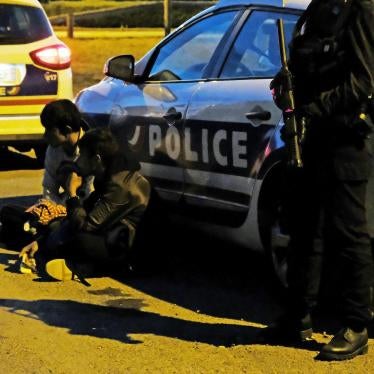In Calais at the end of June, I spoke to a 17-year-old Ethiopian boy (I’ll call him Biniam T.). He said French riot police (the Compagnies républicaines de sécurité, CRS) had sprayed him with a chemical substance as he was walking with some other boys along the side of a road: “It was the daytime, and they came in a van. They sprayed us from the van. They didn’t say anything; they just sprayed.”
It wasn’t the first time I heard such an account—in fact, nearly every one of the children and adults I interviewed had a similar story. Nor was it the only time police had subjected Biniam to such treatment. “If they catch us when we are sleeping, they will spray us and take all of our stuff. Every two or three days they do this,” he said. “This is normal for us. It’s part of our life.”
Conditions for migrants in Calais may soon improve, at least marginally. Interior Minister Gérard Collomb announced on July 31 that the state would open new shelters for migrants, provide access to water, toilets, and showers and investigate reports of excessive use of force by police.
This is a positive, if initial, response to the Human Rights Watch report last week of widespread police abuses against migrants in Calais and a court decision this week from France’s highest administrative court sharply criticizing officials’ refusal to provide water and other humanitarian assistance to migrants. City officials had at first opposed the Interior Ministry’s plans and had vowed not to comply with the court order.
And the minister also challenged our finding that riot police routinely use pepper spray on child and adult migrants when they pose no conceivable threat. A ministry news release stated that police use teargas rather than pepper spray. “I reiterate that in the security forces, there is no use of pepper spray,” he told reporters, adding, “There could be some misconduct by individuals.”
Why the ministry would think tear gas would be better than pepper spray is anyone’s guess. Tear gas (usually containing the chemical agent 2-chlorobenzylidene malononitrile, or CS) and pepper spray cause similar symptoms, including a painful, burning sensation in the eyes and difficulty breathing, although the effects of tear gas often last far longer and can be more severe than those of pepper spray (oleoresin capsicum, OC). Tear gas is a nerve agent, and frequent exposure has been associated with long-term decreases in pulmonary function and increases in respiratory complaints. Put more plainly, people who have been repeatedly exposed to tear gas don’t breathe as well as the average person, even months afterward.
We can say confidently that riot police carry hand-held spray canisters as well as tear gas grenade launchers. I saw both in the hands of police dispersing aid distributions in Calais. Nearly every migrant I spoke with said they had been sprayed by police at close range, usually in the face, most within the previous two weeks. Aid workers said they had witnessed the same, and two aid workers told us a police officer had sprayed them in the face.
It’s possible that the sprays used by the French riot police contain teargas rather than pepper spray. At least one company that sells equipment to French police forces sells hand-held spray canisters containing CS tear gas as well as pepper spray.
We described the chemical sprays used by French riot police in Calais as pepper spray because the symptoms that migrants and those who treated them reported to us were more consistent with pepper spray and news reports on the riot police’s arsenal have stated that it includes pepper spray.
Whatever the police are using, the accounts we heard suggest that they do so routinely and abusively. They also regularly spray or confiscate sleeping bags, blankets, and clothing, and sometimes migrants’ food and water, apparently to pressure them to leave the area. Such acts violate the prohibition on inhuman and degrading treatment and international standards that call for police to use force only when it is unavoidable, and then only in proportion to the circumstances, and for a legitimate law enforcement purpose.
The police abuses we documented in Calais are serious human rights violations. They also adversely affect migrants’ willingness to apply for asylum and, in the case of children, to enter the protection system.
The Interior Ministry’s investigations should assess all relevant evidence, including accounts from aid workers who can corroborate elements of migrants’ accounts—injuries and other symptoms they’ve observed, the repeated requests they receive for sleeping bags and clothing, and abusive practices they’ve witnessed or directly experienced.
Investigators should bear in mind that many people who have been sprayed will be unable to identify individual police officers. Those who can may reasonably fear retaliation. All will need concrete assurances that these investigations will confront bad practices.
The announced investigations are a good start in addressing these pernicious practices—but only if they’re comprehensive, public, and lead to individual sanctions where appropriate.










